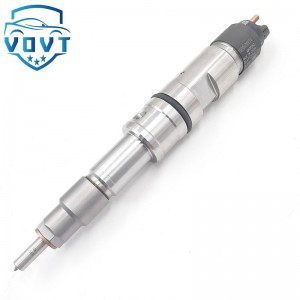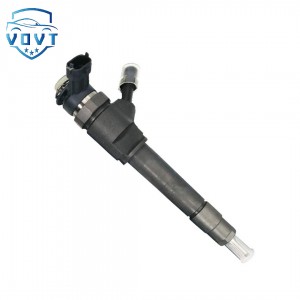Professional Manufacture 0 445 110 273 Diesel Injector Common Rail Injector Engine Parts Vehicle Parts 0445110273
products description
| Reference. Codes | 0 445 110 273 |
| Application | / |
| MOQ | 4PCS |
| Certification | ISO9001 |
| Place of Origin | China |
| Packaging | Neutral packing |
| Quality Control | 100% tested before shipment |
| Lead time | 7~10 working days |
| Payment | T/T, L/C, Paypal, Western Union, MoneyGram or as your requirement |
What are the factors that affect injector responsiveness?
The responsiveness of the injector refers to the time interval from receiving the control signal to completing "opening the injection" or "closing and stopping the injection", which directly affects the injection timing accuracy (such as the timing of pre-injection, main injection, and post-injection) and injection quantity control, and is further related to the engine's combustion efficiency, emissions, and smoothness. The factors affecting its responsiveness can be analyzed from five dimensions: internal structure, actuator performance, fuel and oil circuit, control signal, and environmental conditions, as follows:
Internal mechanical structure factors
The matching accuracy and movement resistance of the injector's mechanical moving parts (such as needle valves, springs, and guide sleeves) are the core factors affecting responsiveness.
Matching state of needle valve pair
The matching clearance between the needle valve and the needle valve body (usually 0.001-0.003mm) needs to be strictly controlled:
If the clearance is too small (such as stuck after wear, carbon deposits blockage), the movement of the needle valve is blocked, which will cause opening delay (cannot be pushed open in time after receiving the signal) or closing delay (continued fuel injection after stopping the signal);
If the clearance is too large (such as excessive wear), high-pressure fuel will leak from the clearance, resulting in insufficient pressure difference at both ends of the needle valve, slowing down the opening speed, and at the same time, the closing responsiveness decreases due to the delay of "return oil pressure relief" when closing.
Performance of pressure regulating spring
The stiffness (elasticity) and fatigue degree of the spring directly affect the return speed of the needle valve:
Insufficient spring elasticity (such as fatigue aging), insufficient reset force when the needle valve is closed, will cause closing delay;
Abnormal spring stiffness (such as deformation during assembly) may change the pressure threshold required for the needle valve to open, indirectly affecting the response speed (higher pressure is required to push open, or it cannot be quickly reset after pushing open).
Mechanical jamming or wear
If the needle valve guide surface and sealing cone surface are worn or scratched due to fuel impurities (such as metal particles, colloid) or high-temperature carbon deposits, it will increase the movement resistance and even cause "jam" (partial or complete inability to move), resulting in complete failure of responsiveness (such as the injector often sprays or does not spray).
Actuator performance factors (for electronically controlled injectors)
Electronic control injectors rely on solenoid valves or piezoelectric crystals as "switches", and their own performance directly determines the response speed.
Response characteristics of solenoid valve
The solenoid valve is the core actuator of the traditional electronic fuel injector, and its responsiveness is related to the following parameters:
Coil parameters: When the coil resistance and inductance are too large, the current rises slowly (the electromagnetic force is delayed), resulting in delayed opening; coil short circuit or aging will cause insufficient electromagnetic force and fail to quickly attract the valve core;
Valve core and armature coordination: If the gap between the valve core and the armature (usually 0.1-0.3mm) is too large, the attraction stroke becomes longer and the response becomes slower; if the gap is too small or there are impurities stuck, it will cause the attraction/release to be blocked and the closing to be delayed;
Return spring: If the return spring of the solenoid valve core is not elastic enough, the valve core will close slowly (release delay).
Performance of piezoelectric crystals (high-pressure common rail system)
Piezoelectric injectors drive needle valves through the "inverse piezoelectric effect" (deformation when energized) of piezoelectric crystals. The response speed is more than 10 times faster than that of solenoid valves (up to microseconds), but its performance is affected by the following factors:
Charging and discharging speed: Piezoelectric crystals need to be deformed through rapid charging and discharging. If the driving circuit (such as the driving module, capacitor) fails, the delay in charging and discharging will directly lead to a slower response;
Crystal aging: Long-term high-frequency deformation may cause fatigue of piezoelectric crystals, a decrease in deformation amplitude or a delayed response, affecting the timeliness of the needle valve opening/closing.
Fuel and oil circuit factors
The physical properties of the fuel and the oil circuit pressure state will affect the responsiveness of the injector through "hydraulic transmission".
Fuel pressure and stability
The fuel injector needs to overcome fuel pressure (such as the rail pressure of the common rail system) to open. When the pressure is too high, the needle valve needs a greater driving force to open, which may cause delay in opening;
Fuel line pressure fluctuations (such as unstable high-pressure pump fuel supply and insufficient common rail pipe volume) will cause the injector inlet pressure to change instantly, resulting in unstable timing of needle valve opening/closing (such as when the pressure drops suddenly, the needle valve may close early).
Physical properties of fuel
Viscosity: When the fuel viscosity increases at low temperatures (such as diesel below 0℃), it will increase the viscous resistance of the needle valve movement, resulting in slower response;
Lubricity: Insufficient fuel lubricity (such as low-sulfur diesel) will aggravate the wear of the needle valve and the needle valve body, indirectly increase the movement resistance, and lead to a long-term decrease in responsiveness;
Impurities and bubbles: Bubbles in the fuel (such as air entering the oil line) will cause "hydraulic transmission lag" (pressure cannot be transmitted to the needle valve instantly), delaying the opening/closing signal; impurities may block the needle valve (as mentioned above).
Oil return channel design
When the injector is closed, the pressure must be quickly relieved through the oil return channel (releasing the high-pressure oil at the rear end of the needle valve). If the oil return channel is blocked, the pipe diameter is too small, or the one-way valve fails, the pressure relief speed will slow down, which will cause a delay in closing (the needle valve cannot be quickly reset).
Control signal and circuit factors
The response of the injector depends on the precise control signal of the ECU (engine control unit). Abnormal signal transmission or processing will directly affect the responsiveness.
ECU control signal parameters
The injection signal (such as pulse width, voltage, frequency) sent by the ECU must match the injector:
If the signal pulse is too short (less than the minimum response time of the injector), the injector may not be fully opened;
If the signal voltage is insufficient (such as excessive voltage drop in the wiring harness), the solenoid valve/piezoelectric crystal will have insufficient driving force and delayed response.
Circuit connection and interference
Poor contact of the injector harness (such as oxidation and looseness of the plug) will cause interruption or attenuation of signal transmission, delaying the actuator action;
Electromagnetic interference (such as interference from high-voltage ignition systems and motor equipment) may cause distortion of control signals, false triggering or delayed triggering of injector action.
Environmental and operating conditions
The engine's operating environment (temperature, vibration, etc.) will indirectly change the responsiveness by affecting the physical state of the components.
Temperature influence
High temperature (such as after the engine is heated) will cause thermal expansion of the injector housing, needle valve, spring and other components:
If the matching clearance design is unreasonable, thermal expansion may reduce the gap between the needle valve and the needle valve body, increase the movement resistance, and slow down the response;
The resistance of the solenoid valve coil increases at high temperature, the current rise speed decreases, and the electromagnetic force is delayed, resulting in a slow opening.
At low temperatures (such as cold start), the fuel viscosity is high and the fluidity is poor, the needle valve movement resistance increases, and the battery voltage may be low (affecting the driving force of the solenoid valve), resulting in decreased responsiveness.
Vibration and installation errors
Severe vibration of the engine may cause the injector to loosen or cause the internal components (such as springs and valve cores) to shift in position, affecting the movement accuracy;
When installing, the coaxiality deviation between the injector and the cylinder head is too large, which may cause uneven force on the needle valve, increase the risk of sticking, and indirectly reduce responsiveness.
Summary
The responsiveness of the injector is the result of the combined effect of mechanical structure accuracy, actuator performance, fuel characteristics, control signals and environmental conditions. Among them, the matching state of the needle valve pair, the performance of the solenoid valve/piezoelectric crystal, and the stability of fuel pressure are the core influencing factors. In actual faults, responsiveness abnormalities are often manifested as "injection timing deviation" (such as early injection, late injection), "multiple injection overlap" (such as too short interval between pre-injection and main injection) or "injection volume fluctuations". It is necessary to accurately locate the cause by detecting the signal and pressure waveform with an oscilloscope, disassembling and checking the wear of mechanical parts, etc.
Related products
| 1 | 5WS40200 | 11 | A2C59514909/ | 21 | 31336585 |
| 2 | FA2C53252642 | 12 | A2C59511602 | 22 | 36001726 |
| 3 | 1685796 | 13 | A2C59513556 | 23 | 1709667 |
| 4 | 31303994 | 14 | 5ws40677 | 24 | 36001727 |
| 5 | 50274V05 | 15 | 50274V0 | 25 | 9445R |
| 6 | 5WS40087 | 16 | 5WS40677 | 26 | 00Q1T |
| 7 | 16600-00Q1T | 17 | AV6Q9F593-AB | 27 | 5WS40007 |
| 8 | 00Q0H | 18 | AV6Q9F593-AA | 28 | A2C59513997 |
| 9 | 5WS40148-Z | 19 | A2C59511606 | 29 | 5WS40250 |
| 10 | 2S6Q-9F593-AB | 20 | 16600-00Q0P | 30 | A2C59514912 |





















